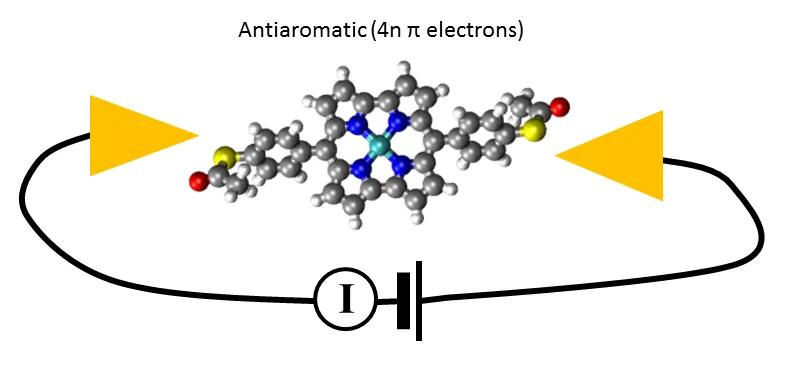A collaboration of Japanese and Czech researchers has realized a molecular circuit involving an antiaromatic molecule for the first time. Antiaromatic molecules have 4n electrons in the π system. They had been predicted decades ago to have remarkable electron transport properties but their instability and difficult synthesis had prevented their study until now. In their paper published in Nature Communications, the authors explain the origin of this high conductance compared to the aromatic counterpart.
A team of Japanese and Czech researchers has measured the electric conductance of an antiaromatic molecular circuit for the first time. Single-molecule circuits are formed when a small organic molecule (the active electronic component) is bridged between two nanoelectrodes. They represent the frontier of miniaturization of electronics and the large pool of organic molecules offers almost unlimited functionalities. Writing in the journal Nature Communications, the authors show that the antiaromatic molecule is much more conducting than its aromatic counterpart. The work opens the way for molecule-scale circuits based on antiaromaticity.
Aromatic molecules have cyclic planar π systems containing 4n+2 electrons (where n is a natural number) and are used extensively in molecular electronics studies, electroluminescent devices and organic photovoltaic cells. Oligoacenes, thiophenes or porphyrins are well-known examples of aromatic compounds. Antiaromatic molecules instead have 4n π electrons and are notoriously unstable and hard to synthesize. In the 1970s electrochemical measurements from oxidation/reduction potentials had suggested that antiaromatic molecules would be very well suited for single-molecule transport. However, efforts in measuring the conductance of a genuinely antiaromatic molecule had not been successful until now. In this recent work, the Japanese-Czech team synthesized and measured an antiaromatic norcorrole-based Ni complex and compared it to its structurally similar porphyrin-based aromatic counterpart.
The Japanese team involved the Kiguchi group from Tokyo Institute of Technology and the Shinokubo group from Nagoya University. They synthesized the compound and used the STM – break junction technique to measure its conductance. An STM tip is brought repeatedly in and out of contact while a small voltage is applied and current is recorded (conductance = inverse of resistance or I/V). In the absence of molecules between tip and sample, exponential decay of the tunnelling current is observed. However, when a molecule is trapped between tip and sample, a characteristic plateau of constant current is observed corresponding to transport across the molecule. Measurements are repeated until a statistically significant dataset is obtained.
Electron transport simulations were carried out by the group of Héctor Vázquez, a Purkyně Fellow at the Institute of Physics of the Czech Academy of Sciences. Narendra P. Arasu and Héctor Vázquez used atomistic simulations to calculate the conducting properties of the aromatic and antiaromatic molecular circuits. Calculations showed that the higher conductance of the antiaromatic molecule is due to its more favourable alignment of frontier orbitals at the interface. An antiaromatic molecular orbital is closer to the Fermi level than in the aromatic system, in agreement with fits to the experimental I-V curves.
In addition to confirming the long-standing prediction on the conductance of antiaromatic molecules, this work demonstrates their potential as highly conducting molecular materials for single-molecule electron transport.
Reference
S. Fujii, S. Marqués-González, J.Y. Shin, H. Shinokubo, T. Masuda, T. Nishino, N.P. Arasu, H. Vázquez and M. Kiguchi, Highly-conducting molecular circuits based on antiaromaticity, Nat. Commun. 8, Article number: 15984 (2017)
